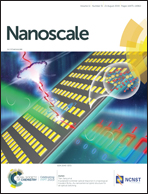A facile alkali metal hydroxide-assisted controlled and targeted synthesis of 1T MoS2 single-crystal nanosheets for lithium ion battery anodes†
Abstract
High-quality metallic 1T phase MoS2 single-crystal nanosheets were synthesized by a facile eco-friendly alkali metal hydroxide-assisted controlled and targeted approach via the calcination of lithium hydroxide and ammonium tetrathiomolybdate under argon atmosphere at 1000 °C. The 1T MoS2 single-crystal nanosheets were used as lithium-ion battery anodes, exhibiting superior electrochemical performances, including long cycle life and high capacities. The first charge and discharge capacities were up to 889.1 mA h g−1 and 892.5 mA h g−1, respectively, giving a first cycle coulombic efficiency of 98.0%, which exceeded 99.1% in the second cycle. In the 400th cycle, the charge and discharge capacities were 737.2 mA h g−1 and 738.0 mA h g−1, respectively, with 82.9% capacity retention ratio. This study not only provides a novel strategy for fabricating metallic 1T phase MoS2, which can be used as lithium ion battery anodes but also introduces a facile eco-friendly lithium hydroxide-assisted controlled and targeted approach for different phase MoS2 (1T and 2H). Moreover, it can be extended to other alkali metal hydroxide-assisted (NaOH and KOH) approaches for the MoS2 preparation.



 Please wait while we load your content...
Please wait while we load your content...
